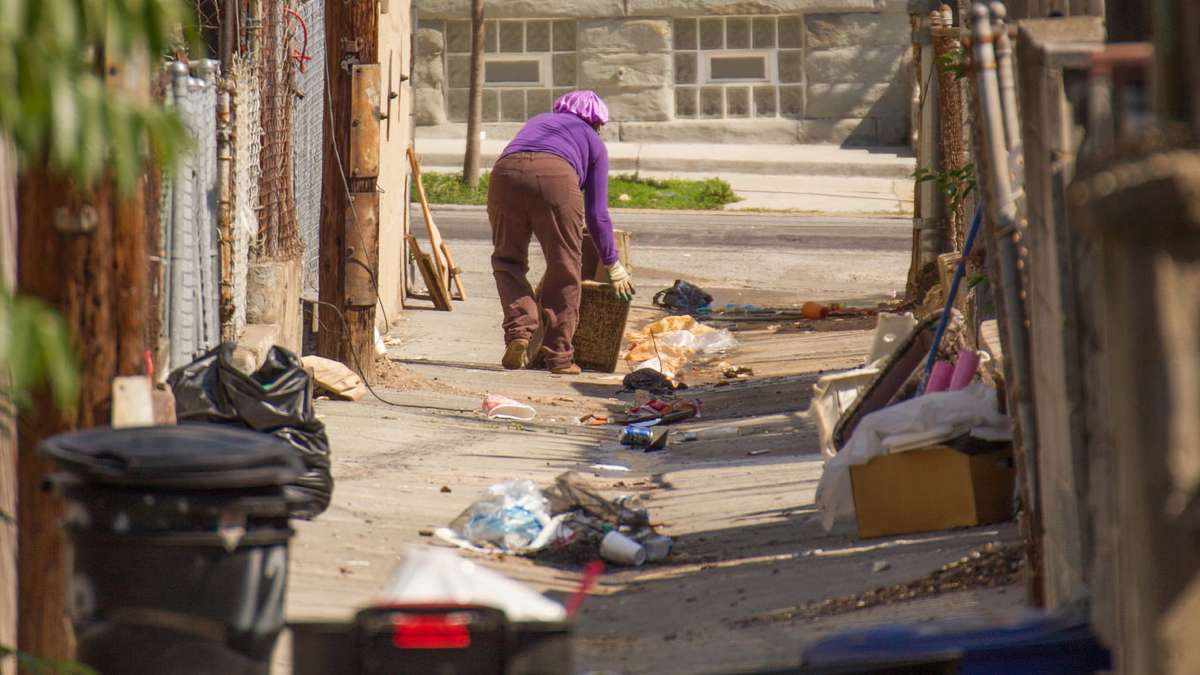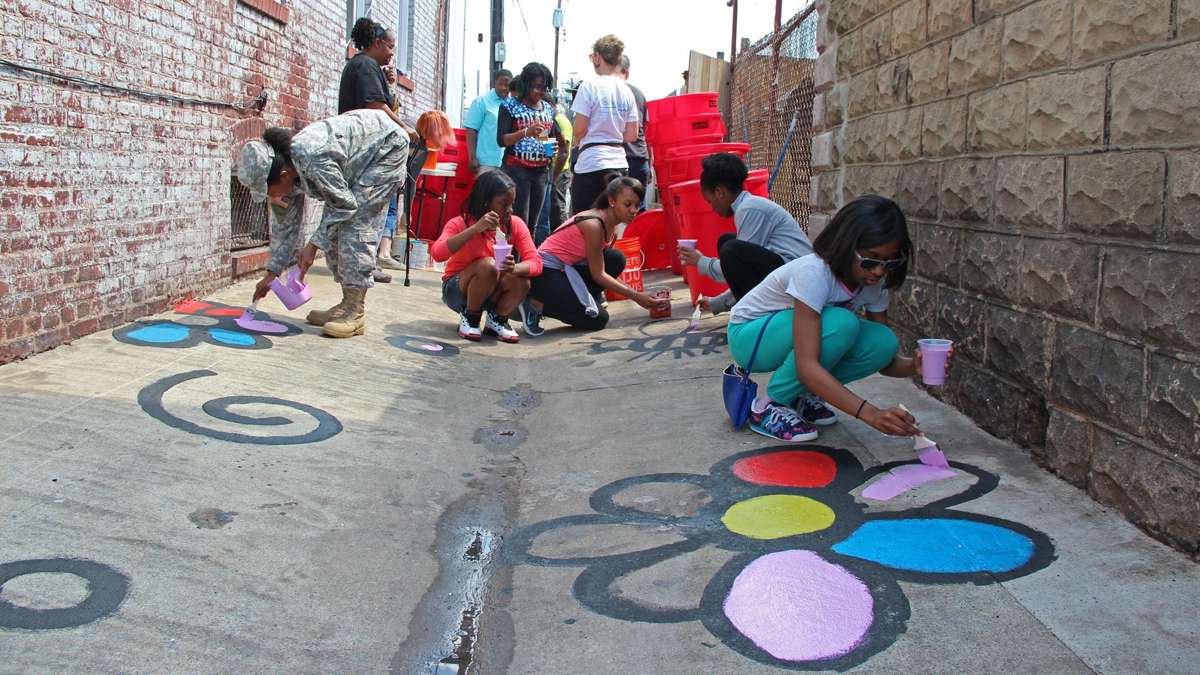In Baltimore, taking back the harbor starts in the alleys
ListenBaltimore’s Inner Harbor is often referred to as the gem of the city. Residents run and shop along the waterfront, and its aquarium and tall ships are among the first stops on a tourist’s itinerary.
But decades after the Clean Water Act was passed, the harbor, much like the rest of the Chesapeake Bay, is still dirty. Storm water and millions of gallons of sewage run into it each year. Dissolved oxygen levels and water clarity remain low. More than a million pounds of trash were removed from the Harbor by a new water wheel and trash skimmers just last year.
After years of clean-up efforts, one group is turning its attention far away from the Harbor to the city’s back alleys in hope of stemming the tide of trash.
Neighborhoods in flux
Paula Ellerbe has lived in the McElderry Park neighborhood of East Baltimore for more than 30 years. She remembers when her backyard and the alley behind it were nice places to be.
“Back in the day we had trees, rose bushes, and my husband used to plant okra… and tomatoes,” Ellerbe said.
Neighborhood kids rode their bikes and played basketball in the alley.
“You’d go out in your back and you’d have your barbeque and the kids enjoyed the alleys and it was beautiful,” Ellerbe said.
Then, about ten years ago, Ellerbe’s alley became a dumping ground.
She blames it on more renters with absentee landlords moving onto the block. Others point to the long-lasting impacts of red-lining, institutional racism, the crack epidemic and other twentieth century urban scourges that hit Baltimore particularly hard.
Whatever the root cause, the alley behind Ellerbe’s house eventually filled up with garbage bags, loose trash and mattresses. And with that trash came rats.
“And then the rats started making tunnels,” Ellerbe said. “So my husband and I decided now we had to get the rats out and concrete.”
Ellerbe paved over her backyard six or seven years ago, and her neighbors eventually followed suit. The concrete didn’t get rid of the problem, though, and the alley behind her house remained trash-strewn and rat-infested.
It remained that way until this summer, when Ellerbe’s alley got a makeover: neighbors pulled weeds and picked up trash, and an artist painted a “No dumping” sign on a wall near her house.
In what may seem a counter-intuitive partnership, the cleanup was sponsored by the Healthy Harbor Initiative, which aims to make the Inner Harbor fishable and swimmable by the year 2020.
Cleaning up upstream
When trash accumulates anywhere, even in a city, it tends to flow downstream. In Baltimore, that means much of what gets dumped in the 600 miles of Baltimore’s alleys ultimately ends up in the Inner Harbor.
“So we collect trash at the Inner Harbor, but we also realize that in order to have clean water, we need to work upstream,” said Leanna Wetmore, a community organizer leading the alley makeover program for the Healthy Harbor Initiative.
Trash that is thrown into the alleys surfs into storm drains when it rains, and eventually passes through storm water pipes and is released into the Inner Harbor.
“You can do clean-ups all day long and it’s not sustainable,” Wetmore said. “So we designed this alley makeover project as sort of a fun, light way to work on trash.”
The Healthy Harbor Initiative launched the alley makeover program in April and has since distributed free trash and recycling bins to neighbors in 18 alleys scattered throughout six neighborhoods. Professional artists and neighbors have painted or stenciled art on the walls, ground or trash can enclosures in each of those alleys.
A $30,000 grant helped with the community organizing and materials. The residents supplied the elbow grease.
“We pulled up weeds, we cleaned it up real good,” said Paula Ellerbe. “We worked.”
Ellerbe remembers two mattresses being pulled out of a neighbor’s yard and rats running out of it.
Now, Ellerbe’s alley has a graffiti-style painting with big bubble letters a few houses down from hers that reads “No dumping.” The alley is still free of trash and weeds.
So is the alley behind Sadie Drescher’s house, in Patterson Park, the neighborhood just to the south of McElderry Park.
Neighborhood kids painted flowers with big, brightly colored petals on the cement ground during an alley makeover just two weeks ago.
“We gave out over 120 trash bins and recycle bins to the neighbors,” Drescher said. “People are kind of coming back out into the alley, and it’s pretty and it’s not so scary.”
Loose connection to the city’s waterways
One of the art pieces commissioned for the makeover program depicts a stream of blue water filled with fish, clams and a crab painted onto the ground. It’s made to look like the water is flowing into a storm drain in the middle of one of the improved alleys, a subtle reminder of the connection between the alley and Baltimore’s waterways.
That was the only reminder I saw that the aim of the entire project is to prevent trash from flowing into the Harbor.
Halle Van der Gaag, director of the environmental group Blue Water Baltimore, said that was a strategic decision.
“We find in Baltimore that people may not care about the [Chesapeake] Bay or the Inner Harbor, but they really care about trash and rats and what’s happening in their back alley and their neighborhood,” Van der Gaag said.
“We used to go in [to neighborhoods] talking about storm water and sewage and healthy waterways, and now we really talk about healthy communities. “
Indianapolis, Los Angeles and Louisville have also targeted alleys for clean-up, but none of these projects were spurred primarily by the desire to keep trash out of local waterways like this project in Baltimore.
Other cities, led by Chicago in 2006, have launched “green alley” programs that encourage residents to repave with light-reflecting, permeable pavement to reduce both storm water runoff and the urban “heat island” effect.
Wetmore plans to partner with the City of Baltimore to expand the “alley makeover” program to more neighborhoods soon.
Clean water advocates also hope a $10 million mayoral pledge to give every household a free trash can with a lid will help reduce litter throughout the city.
As for Paula Ellerbe, she has visions of someday ripping up the concrete and re-planting a garden in her backyard.
“I would love that, I would love that,” Ellerbe said. “I’m not a country girl…but give me some okra and some tomatoes and I’m good.”
Reporting for this story was made possible, in part, by a fellowship from the Institute for Journalism and Natural Resources.
WHYY is your source for fact-based, in-depth journalism and information. As a nonprofit organization, we rely on financial support from readers like you. Please give today.





